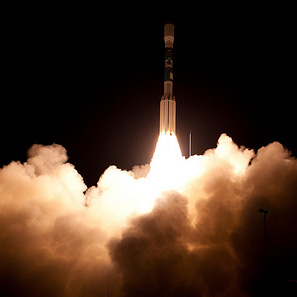Agencies hope the next-generation satellite will serve as a bridge between the nation’s aging satellite fleet and the new ones yet to come.

In a joint effort to improve observations of the Earth from space, NASA and NOAA launched a new satellite on Friday from Vandenberg Air Force base near Lompoc, CA. The satellite carries with it a suite of next-generation technologies and tools that the agencies say will enable scientists to continue monitoring climate change and weather patterns as many existing Earth-observing satellites are reaching the outer edge of their life expectancies.
The new satellite is part of the NPOESS Preparatory Project (NPP), which aims to monitor the entire planet, collecting and processing data on the Earth’s weather, atmosphere, oceans, land, and near-space environment. The agencies say this data will not only help with monitoring climate change, but also with natural disaster prediction and planning, and military strategies. NASA describes the NPP as a bridge between the aging Earth Observation System (EOS) satellites and the “forthcoming” Joint Polar Satellite System (JPSS) satellites, which are scheduled to begin launching in 2016.
NASA lists the key science objectives and capabilities of NPP as the following:
- Climate change — contribute to long-term records of global environmental data critical for understanding the dynamics of climate change
- Health of the ozone layer — daily measurements of the atmospheric ozone layer that will determine whether the ozone layer is recovering as expected
- Natural disasters — monitor wildfires, volcanic eruptions, snowstorms, droughts, floods, hurricanes and dust plumes
- Weather predictions — a sounding instrument will collect information about cloud cover, atmospheric temperatures, humidity and other variables critical to accurate weather prediction
- Vegetation — map global land vegetation and quantify changes in plant productivity to understand the global carbon cycle and monitor agricultural processes to predict and respond to food shortages and famines
- Global ice cover — monitor changes to Earth’s sea ice, land ice and glaciers to track the pace of climate change
- Air pollution — monitor the spread of health-sapping pollutants such as soot, particulate matter, nitrogen dioxide and sulfur dioxide
- Temperatures — maintain a global record of atmospheric, land surface and sea surface temperatures critical to understanding the long-term dynamics of climate change
- Earth’s energy budget — make measurements to determine how much energy is entering and exiting Earth’s atmosphere
As The New York Times and Popular Mechanics report, it’s been a bumpy road getting the NPP program off the ground, and the budget for future satellites and launches is far from secure in the current economic climate. Too long a delay, scientists warn, could affect not just the nation’s ability to monitor climate change, but could also impact weather prediction and natural disaster preparedness.
For more about the NPP satellite, check out this video from Space.com
Or, if you’d rather have it explained to you by a cartoon polar bear, you can watch this NASA video for the basics:
